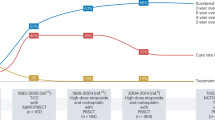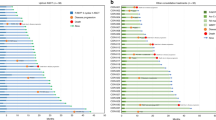Abstract
Sequential high-dose chemotherapy (HDCT) with autologous stem cell transplantation (ASCT) is a curative option in relapsing germ cell tumor (GCT) patients, and complete remission (CR) after the first ASCT (early CR2) is associated with favorable outcome. Prognostic factors predicting early CR2 have not been investigated so far. We analyzed consecutive patients with a first relapse of GCT treated with three sequential cycles of carboplatin/etoposide-based HDCT with ASCT in the two largest academic centers in Switzerland. The cohort comprised 96 relapsing GCT patients, with 19 (19.8%) patients achieving early CR2 after the first HDCT cycle. The median progression-free survival and overall survival were not reached in patients achieving early CR2, whereas they were 9.6 months (P = 0.0301) and 34.8 months (P = 0.0684) for patients missing early CR2. Patients with early CR2 more often had CR1 after first-line bleomycin, etoposide, and cisplatin chemotherapy (68.4 vs. 31.6%; P = 0.0037) and an interval longer than 2 years between initial diagnosis and first HDCT (36.8 vs. 15.6%; P = 0.0373), but less often a histology of mixed nonseminomatous tumor (46.8 vs. 21.1%; P = 0.0418). These data suggest that response to first-line chemotherapy, late relapse, and histology are associated with achieving early CR2 after a first HDCT with ASCT in relapsing GCT patients.
This is a preview of subscription content, access via your institution
Access options
Subscribe to this journal
Receive 12 print issues and online access
$259.00 per year
only $21.58 per issue
Buy this article
- Purchase on Springer Link
- Instant access to full article PDF
Prices may be subject to local taxes which are calculated during checkout

Similar content being viewed by others
References
Beyer J, Kingreen D, Krause M, Schleicher J, Schwaner I, Schwella N, et al. Long term survival of patients with recurrent or refractory germ cell tumors after high dose chemotherapy. Cancer. 1997;79:161–8.
Einhorn LH, Williams SD, Chamness A, Brames MJ, Perkins SM, Abonour R. High-dose chemotherapy and stem-cell rescue for metastatic germ-cell tumors. N Engl J Med. 2007;357:340–8.
Lorch A, Bascoul-Mollevi C, Kramar A, Einhorn L, Necchi A, Massard C, et al. Conventional-dose versus high-dose chemotherapy as first salvage treatment in male patients with metastatic germ cell tumors: Evidence from a large international database. J Clin Oncol. 2011;29:2178–84.
Nichols CR, Tricot G, Williams SD, van Besien K, Loehrer PJ, Roth BJ, et al. Dose-intensive chemotherapy in refractory germ cell cancer—a phase I/II trial of high-dose carboplatin and etoposide with autologous bone marrow transplantation. J Clin Oncol. 1989;7:932–9.
Nichols CR, Andersen J, Lazarus HM, Fisher H, Greer J, Stadtmauer EA, et al. High-dose carboplatin and etoposide with autologous bone marrow transplantation in refractory germ cell cancer: an Eastern Cooperative Oncology Group protocol. J Clin Oncol. 1992;10:558–63.
Broun ER, Nichols CR, Turns M, Williams SD, Loehrer PJ, Roth BJ, et al. Early salvage therapy for germ cell cancer using high dose chemotherapy with autologous bone marrow support. Cancer. 1994;73:1716–20.
Siegert W, Beyer J, Strohscheer I, Baurmann H, Oettle H, Zingsem J, et al. High-dose treatment with carboplatin, etoposide, and ifosfamide followed by autologous stem-cell transplantation in relapsed or refractory germ cell cancer: a phase I/II study—The German Testicular Cancer Cooperative Study Group. J Clin Oncol. 1994;12:1223–31.
Motzer RJ, Mazumdar M, Bosl GJ, Bajorin DF, Amsterdam A, Vlamis V. High-dose carboplatin, etoposide, and cyclophosphamide for patients with refractory germ cell tumors: treatment results and prognostic factors for survival and toxicity. J Clin Oncol. 1996;14:1098–105.
Motzer RJ, Mazumdar M, Sheinfeld J, Bajorin DF, Macapinlac HA, Bains M, et al. Sequential dose-intensive paclitaxel, ifosfamide, carboplatin, and etoposide salvage therapy for germ cell tumor patients. J Clin Oncol. 2000;18:1173–80.
Lorch A, Kleinhans A, Kramar A, Kollmannsberger CK, Hartmann JT, Bokemeyer C, et al. Sequential versus single high-dose chemotherapy in patients with relapsed or refractory germ cell tumors: long-term results of a prospective randomized trial. J Clin Oncol. 2012;30:800–5.
Lorch A, Kollmannsberger C, Hartmann JT, Metzner B, Schmidt-Wolf IG, Berdel WE. et al. German Testicular Cancer Study Group. Single versus sequential high-dose chemotherapy in patients with relapsed or refractory germ cell tumors: a prospective randomized multicenter trial of the German Testicular Cancer Study Group. J Clin Oncol. 2007;25:2778–84.
Gerl A, Clemm C, Schmeller N, Hartenstein R, Lamerz R, Wilmanns W. Prognosis after salvage treatment for unselected male patients with germ cell tumours. Br J Cancer. 1995;72:1026–32.
Beyer J, Kramar A, Mandanas R, Linkesch W, Greinix A, Droz JP, et al. High-dose chemotherapy as salvage treatment in germ cell tumors: a multivariate analysis of prognostic variables. J Clin Oncol. 1996;14:2638–45.
Fossa SD, Stenning SP, Gerl A, Horwich A, Clark PI, Wilkinson PM, et al. Prognostic factors in patients progressing after cisplatin-based chemotherapy for malignant non-seminomatous germ cell tumours. Br J Cancer. 1999;80:1392–9.
Motzer RJ, Nichols CJ, Margolin KA, Bacik J, Richardson PG, Vogelzang NJ, et al. Phase III randomized trial of conventional-dose chemotherapy with or without high-dose chemotherapy and autologous hematopoietic stem-cell rescue as first-line treatment for patients with poor-prognosis metastatic germ cell tumors. J Clin Oncol. 2007;25:247–56.
Sammler C, Beyer J, Bokemeyer C, Hartmann JT, Rick O. Risk factors in germ cell tumour patients with relapse or progressive disease after first-line chemotherapy: evaluation of a prognostic score for survival after high-dose chemotherapy. Eur J Cancer. 2008;44:237–43.
Lorch A, Beyer J, Bascoul-Mollevi C, Kramar A, Einhorn LH, Necchi A, et al. Prognostic factors in patients with metastatic germ cell tumors who experienced treatment failure with cisplatin-based first-line chemotherapy. J Clin Oncol. 2010;28:4906–11.
Gössi F, Spahn M, Zweifel M, Samaras P, Mischo A, Stenner F, et al. Comparison of three or fewer high-dose chemotherapy cycles as salvage treatment in germ cell tumors in first relapse. Bone Marrow Transplant. 2016;52:334–6.
Kaplan EL, Meier P. Nonparametric estimation from incomplete observations. J Am Stat Assoc. 1958;53:457–81.
Fankhauser CD, Curioni-Fontecedro A, Allmann V, Beyer J, Tischler V, Sulser T, et al. Frequent PD-L1 expression in testicular germ cell tumors. Br J Cancer. 2015;113:411–3.
Acknowledgements
We thank the data management team of the university hospitals in Bern and Zurich for providing data used in this study. This work was supported by grants from the Swiss Cancer League (#38–167).
Author contributions
FG performed research and analyzed data; MS contributed vital material; PS contributed vital material; JB contributed vital material; JS contributed vital material; and TP designed research and analyzed data. All authors participated in drafting or reviewing the report, and all authors approved the submitted version.
Author information
Authors and Affiliations
Corresponding author
Ethics declarations
Conflict of interest
The authors declare that they have no conflict of interest.
Rights and permissions
About this article
Cite this article
Gössi, F., Spahn, M., Samaras, P. et al. Response to first-line treatment and histology are associated with achieving complete remission after the first salvage high-dose chemotherapy in relapsing germ cell tumor patients. Bone Marrow Transplant 53, 820–825 (2018). https://doi.org/10.1038/s41409-018-0089-5
Received:
Revised:
Accepted:
Published:
Issue Date:
DOI: https://doi.org/10.1038/s41409-018-0089-5



